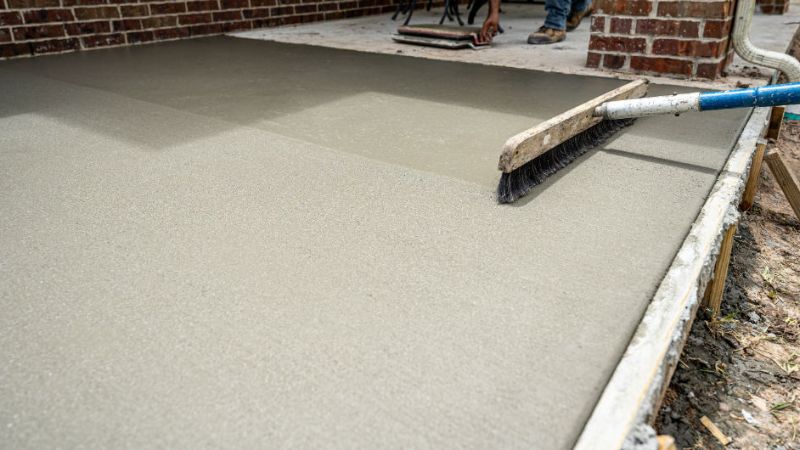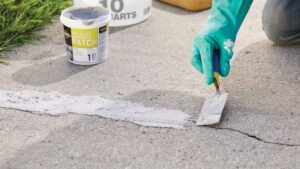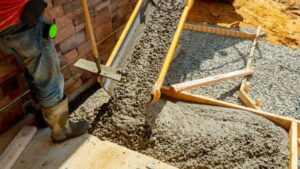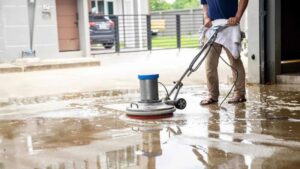Concrete finishes offer endless possibilities to enhance the aesthetic and functionality of your surfaces. Whether you’re designing a patio, driveway, or an interior floor, choosing the right concrete finish can dramatically change the appearance and durability of your project.
From smooth and sleek to textured and slip-resistant, there are various finishes to suit every taste and requirement. Understanding the different types of concrete finishes will help you make informed decisions and achieve the desired look for your space. In this blog, we will explore the 7 most popular concrete finishes that are widely used in modern construction and landscaping projects.
7 Different Types of Concrete Finishes
1. Brushed Concrete Finish
A brushed concrete finish is achieved by dragging a broom or specialized brush across the surface of freshly poured concrete, creating fine lines and texture. This type of finish is one of the most popular for outdoor surfaces like driveways, sidewalks, and patios due to its slip-resistant properties. The texture provided by brushing prevents surfaces from becoming too smooth, which could lead to slippery conditions when wet.
Brushed concrete is also cost-effective, as it requires minimal materials and labor. Moreover, this finish is highly customizable; you can adjust the texture by using different bristle types and brushing techniques, allowing for various designs or levels of roughness. Despite its simplicity, a brushed concrete finish offers both functional and aesthetic benefits for outdoor applications.
Also Read:- Tips For Choosing The Right Concrete Mix
2. Polished Concrete Finish
Polished concrete finishes are widely recognized for their sleek, glossy appearance and durability. This finish involves mechanically grinding the surface of the concrete with progressively finer grits until the desired level of polish is achieved. Polished concrete is commonly used in commercial spaces, modern homes, and retail settings due to its high reflectivity and low maintenance requirements.
The finish not only enhances the visual appeal of the concrete but also improves its strength and longevity. Polished surfaces are easy to clean, stain-resistant, and do not require waxing or sealants, which reduces maintenance costs over time. Another benefit is its eco-friendliness, as it typically utilizes existing concrete without additional coatings or materials. In environments where aesthetics and functionality meet, polished concrete finishes are a top choice.
3. Stamped Concrete Finish
A stamped concrete finish offers the perfect combination of durability and aesthetic appeal, often mimicking the look of natural materials like stone, brick, or tile. This finish is created by pressing molds or stamps into freshly poured concrete to create textures and patterns. It’s a popular choice for driveways, patios, walkways, and even pool decks due to its ability to replicate high-end materials at a fraction of the cost.
In addition to its visual benefits, stamped concrete is long-lasting and can withstand heavy foot traffic and weather exposure. The color of the stamped concrete can also be customized through staining or the use of colored pigments mixed into the concrete. With proper maintenance, stamped concrete can maintain its beauty and integrity for decades, making it an excellent choice for both residential and commercial applications.
4. Exposed Aggregate Finish
An exposed aggregate finish showcases the natural beauty of the concrete’s internal materials, such as stones, pebbles, and small aggregates. To achieve this look, the surface of freshly poured concrete is carefully washed away to reveal the underlying stones and aggregate. This finish is highly popular for outdoor areas like driveways, patios, and pool decks because of its visual texture and durability.
The stones used in exposed aggregate can vary in size and color, providing endless design possibilities for customization. Additionally, this type of finish offers slip resistance, making it a safe option for high-traffic or wet areas. While the surface may feel rough to the touch, it is long-lasting and requires minimal maintenance beyond periodic sealing to protect the exposed stones from wear and tear.
5. Salt Finish Concrete
Salt finish concrete is commonly used for pool decks and outdoor spaces, offering a subtle texture and a visually appealing surface. This finish is created by applying rock salt crystals to the surface of freshly poured concrete and then washing them away after the concrete has set, leaving small, shallow pits. The result is a unique, speckled texture that not only enhances the appearance but also provides slip resistance, making it ideal for wet areas.
Salt finish concrete can be used with various color schemes, allowing homeowners and designers to incorporate it into many landscape designs. The durability of this finish is another advantage, as the subtle indentations created by the salt help prevent cracking over time. Regular sealing can help maintain the integrity and appearance of salt finish concrete, ensuring its longevity.
6. Troweled Concrete Finish
A troweled concrete finish is smooth and polished, achieved by using a trowel to smooth out the surface of the concrete after it has been poured. This finish is popular for both indoor and outdoor applications, including basements, garages, and patios. Troweling can be done by hand or with power trowels, depending on the size of the area and the desired smoothness.
For a sleek, modern look, many prefer a burnished trowel finish, which adds a slight sheen to the surface. While a troweled finish can create a refined, clean look, it does require a skilled hand to ensure that the surface is even and free of imperfections. Additionally, it’s important to keep in mind that a highly troweled finish may become slippery when wet, so it’s better suited for indoor or sheltered environments.
Also Read:- Benefits of Fiber-Reinforced Concrete
7. Colored Concrete Finish
Colored concrete finishes allow for a wide range of aesthetic possibilities by incorporating color directly into the concrete mix or applying it to the surface after pouring. The color can be achieved using pigments, stains, or dyes, and it can be customized to match virtually any design scheme. This type of finish is popular for decorative purposes in both residential and commercial settings, including patios, driveways, and walkways.
The color is not only long-lasting but can also enhance the durability of the concrete by reducing the appearance of stains and imperfections. Colored concrete is highly versatile, offering options for everything from subtle earth tones to bold, vibrant hues. Regular sealing helps maintain the vibrancy and appearance of the color, ensuring that it remains an eye-catching feature for years to come.
Conclusion
Choosing the right concrete finish can make all the difference in the appearance, texture, and performance of your surfaces. With the wide variety of options available, there’s a finish that fits every style and function. From stamped designs to polished surfaces, each type offers its own benefits. When selecting a finish, consider factors like durability, maintenance, and safety. By doing so, you’ll ensure a long-lasting and visually appealing result for your concrete project.
FAQs
What is the most durable concrete finish?
Polished concrete is known for its durability and low maintenance, making it a popular choice for high-traffic areas.
Can concrete finishes be applied to existing surfaces?
Yes, many finishes like staining and polishing can be applied to existing concrete, rejuvenating the surface without the need for replacement.




